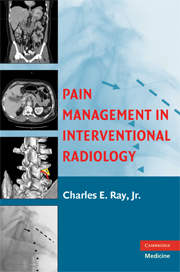Book contents
- Frontmatter
- Contents
- Contributors
- Preface
- Acknowledgments
- 1 Pain Management in Interventional Radiology: An Introduction
- 2 Clinical Evaluation of Low-Back Pain
- PART I LOCOREGIONAL PAIN CONTROL
- PART II SYSTEMIC PAIN CONTROL
- 16 Sedation and Analgesia Medications
- 17 Guidelines for Sedation Administered by Nonanesthesiologists
- 18 Pediatric Sedation for Radiological Imaging Studies and Interventions
- 19 Nontraditional Pain Management in Interventional Radiology
- 20 Postprocedural Pain Control
- Index
- References
18 - Pediatric Sedation for Radiological Imaging Studies and Interventions
from PART II - SYSTEMIC PAIN CONTROL
Published online by Cambridge University Press: 04 September 2009
- Frontmatter
- Contents
- Contributors
- Preface
- Acknowledgments
- 1 Pain Management in Interventional Radiology: An Introduction
- 2 Clinical Evaluation of Low-Back Pain
- PART I LOCOREGIONAL PAIN CONTROL
- PART II SYSTEMIC PAIN CONTROL
- 16 Sedation and Analgesia Medications
- 17 Guidelines for Sedation Administered by Nonanesthesiologists
- 18 Pediatric Sedation for Radiological Imaging Studies and Interventions
- 19 Nontraditional Pain Management in Interventional Radiology
- 20 Postprocedural Pain Control
- Index
- References
Summary
Infants and children, who undergo radiological imaging studies, whether diagnostic or interventional, may require sedation. Sedation may be indicated in order to minimize motion artifact, facilitate successful completion of the procedure and, potentially, minimize risk to the patient (e.g., a sedation that would be required to achieve a cerebral angiogram in order to minimize risk of vascular damage related to the patient inadvertently moving during the study). There are a variety of sedatives available; most of the standard and most popular sedatives have been in existence for almost 100 years.
Triaging patients as being appropriate to receive sedation is the first important step in managing these children. Sedation may be administered by a variety of health care professionals that include a physician (radiologist, hospitalist, emergency medicine, pediatric, intensivist), nurse, or nurse practitioner. With the advent of new Current Procedural Terminology (CPT) billing codes in January 2006, there is now a billing code that enables a physician to bill for being physically present and responsible throughout the sedation. There are moderate sedation codes that reflect services provided by the same physician performing the diagnostic or therapeutic service that the sedation supports as well as codes for sedation services provided by a physician (other than an anesthesiologist) other than the health care professional performing the diagnostic or therapeutic service. As a consequence of these new billing codes, an increasing number of nonanesthesiologists are taking an active interest in delivering and setting up their own sedation services.
- Type
- Chapter
- Information
- Pain Management in Interventional Radiology , pp. 268 - 279Publisher: Cambridge University PressPrint publication year: 2008



